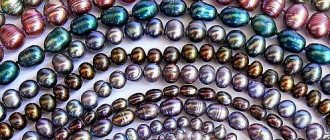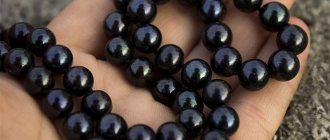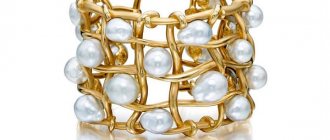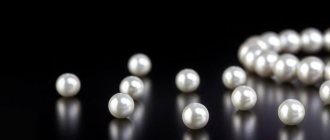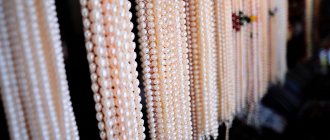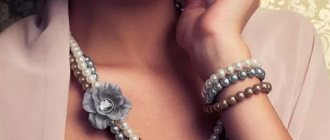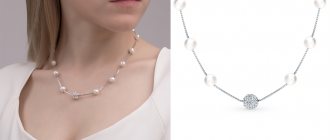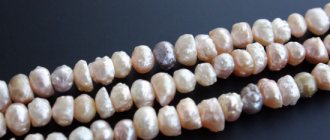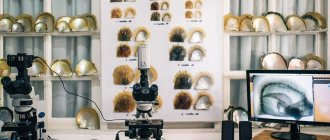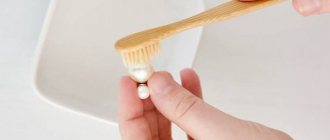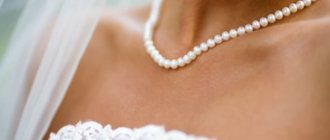Hello! Let's talk about the diversity of pearls in the wild and on man-made farms. The shimmering “surprises” in mollusk shells are a real miracle. People have known the secret of oysters since ancient times. Even then, hundreds of years ago, merchants were ready to pay in gold for natural treasures obtained by divers from the bottom of the seas and oceans. Born in the depths, exclusively all types of pearls are worthy of attention. Just imagine how a sparkling pebble is formed in a shell, how much time it takes and what efforts a person makes to grow the best specimens on his own! You will understand that the high price of pearl products is completely justified.
Let's talk about what types of pearl peas are found in nature, whether any of them can be grown by cultivation and what features they have. We will also consider rare populations of pearl-bearing mollusks, some of which are rightly considered one of the most ancient organisms on Earth.
What determines the “appearance” of a frozen “tear”?
What a pearl looks like depends primarily on the type of oyster. For people, both many hundreds of years ago and today, the color and size of the formations are of greatest value. The shade depends on the following factors:
- varieties and spheres of life of the mollusk;
- overtones;
- reflection.
The main color of the flickering formation is associated not only with the type of organism, but also with the environment in which it lives. An equally important indicator is overtone. Each pearl has an additional shade in addition to the main color. Finally, reflection is the ability of an organic pebble to play with light. The intensity of the color shimmer depends on the number of mother-of-pearl layers.
The longer the formation is inaccessible to humans, ripening inside the shell of the inhabitant of the day, the more saturated its color will eventually turn out. Typically, the most intense overtone and brightness are found in pebbles starting from 0.6 units, often obtained from marine organisms.
The shade is also influenced by the cleanliness of the walls of the body’s shell and the state of its health. In addition, the components in the composition of the water, the temperature of the seabed and water, and other equally important factors play a role.
Typically, pink pearls are formed in the shells of oysters that live in waters with a high amount of manganese in their composition; more often the formations have a standard white or yellowish color, less often - blue, orange, purple and others.
Organic pink pebbles are mined mainly in the Indian Ocean. Their shades vary from beige to pink of varying degrees of intensity. Unusual “drops of mother of pearl” are mined in Panama. This region is characterized by pearls of black and luxurious gold shades. Mexico has absolutely amazing red formations, while Australia and Japan have classic light ones.
Rare and expensive gray pearls are grown mainly on the island of Tahiti. Yellow colored specimens are found in the Red Sea.
Freshwater beads are available in the same variety of colors as marine beads. They have learned to grow them in almost every country.
Let's look at the most interesting varieties with a description of their features.
What affects the price of cultured pearls
The cost of cultured pearls grown in sea conditions is almost 10 times higher than river specimens.
View this post on Instagram
Publication from NATURAL STONES • ACCESSORIES (@silver_kamni)
This is due to higher production costs.
The prices of pearls of the same type can be influenced by:
- Shine intensity: the brighter the shimmer, the more expensive it is.
- Shape: spherical pearls are the most valuable.
- Color: the most expensive and rare are black and red varieties .
- The size of the pearl and the thickness of the nacre layer: the price is directly proportional to these criteria.
Refinement of cultured pearls
Grown pearls are not always of jewelry quality. To protect themselves from losses, they came up with several ways to refine unsightly pearls.
Refinement methods
The mother-of-pearl layer can be painted on the outside in a more “expensive” color. Sometimes the shine is enhanced by treating the beads with methyl alcohol or mineral salts. The disadvantage of this method is that in the period from 6 months to 2 years the effect is lost and the pearl regains its original appearance.
Even cracks and dents are not rejected by some manufacturers, but are covered with silicone and epoxy resin . Such manipulations are noticeable under a magnifying glass upon careful examination.
The best type of cultured pearls
The elite varieties of cultured pearls are those from the South Seas and Tahiti. Most high-end jewelry uses Akoya pearls.
Frame and price: how they are related
The final cost of pearl jewelry is influenced by the precious metal that frames the stones. For example, an expensive black pearl is encased in platinum of approximately equal value, which doubles the price of the finished product.
Lesser quality specimens are framed in silver.
Baroque formations: how to identify
Almost all beads of irregular shape, which are as natural as possible for such formations, fall under the “Baroque” category. It is important that baroque pearls refer to material mined in different parts of the world. Its non-standard appearance and unique outline make it attractive to use for inlaying designer jewelry. Instead of the usual ideal sphere, Baroque beads can look like:
- pears;
- drops;
- cylinder;
- buttons.
The most interesting option is paragons.
These are formations with certain specific outlines, for example, birds, animals and even people. This kind of pearl is cultivated by humans, so its price is more affordable than in the case of completely wild organic stones. Jewelry with shaped baroque is chosen for oneself as amulets and talismans. Another distinctive feature of the beads is their ribbed surface. It is enough to move the ball along the sand to see the characteristic wavy patterns. Each baroque pearl is unique, which is confirmed by the high price.
How to dye pearls
To obtain colored pearls, they are cultured in different types of mollusks. The inner surface of the shells consists of the same substances as the pearl, so its pigment determines the color of the pearls.
For example, the Royal Strombus clam produces a deep pink pearl. A similar shade is also grown in giant tridacnas.
The Haliotis mollusk produces a blue-green color with many iridescences, and the shells themselves are used for decoration or art objects.
The golden-colored pearls are grown inside the melon shell.
Blister: how to distinguish
The “blister” category includes pearls with an unusual choice for placement inside the shell. If traditionally foreign bodies are overgrown with mother-of-pearl in the mantle of the oyster, then in the case of blisters we are talking about attaching them to one of the inner walls. The result of an erroneous choice is adherence to the wall and the absence of a pearlescent layer at the attachment point.
To hide flaws, jewelers process pearls and often use them to create necklaces and chokers, masking “bald spots” with holes for threads.
Another interesting name for blister beads is bubble, which fully confirms the features of the non-standard appearance.
Defects: which are acceptable and which are not
Once the pearls are removed from their shells, they are assessed according to a variety of parameters:
- form;
- color;
- shine;
- defects.
The last parameter is considered the most important: if a pearl of ideal shape and color has unacceptable defects, it will not be used for further jewelry production.
According to this criterion, pearls are divided into classes . AAA class minerals, free from any defects, have the highest degree of purity. Pearls with acceptable defects (indentations or bulges, spots invisible to the naked eye) are assigned class AA+ or AA.
View this post on Instagram
Publication from SEQUINS
